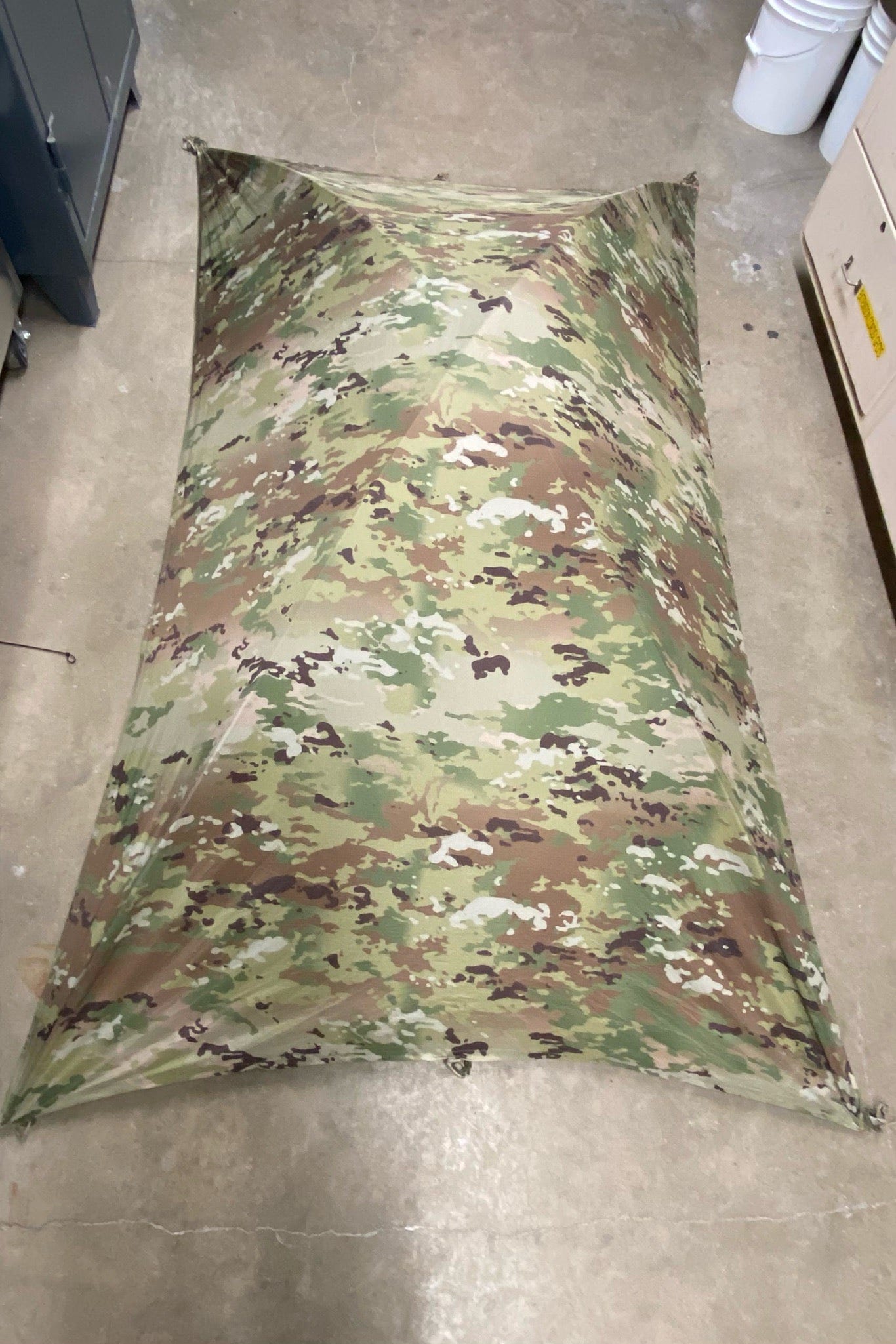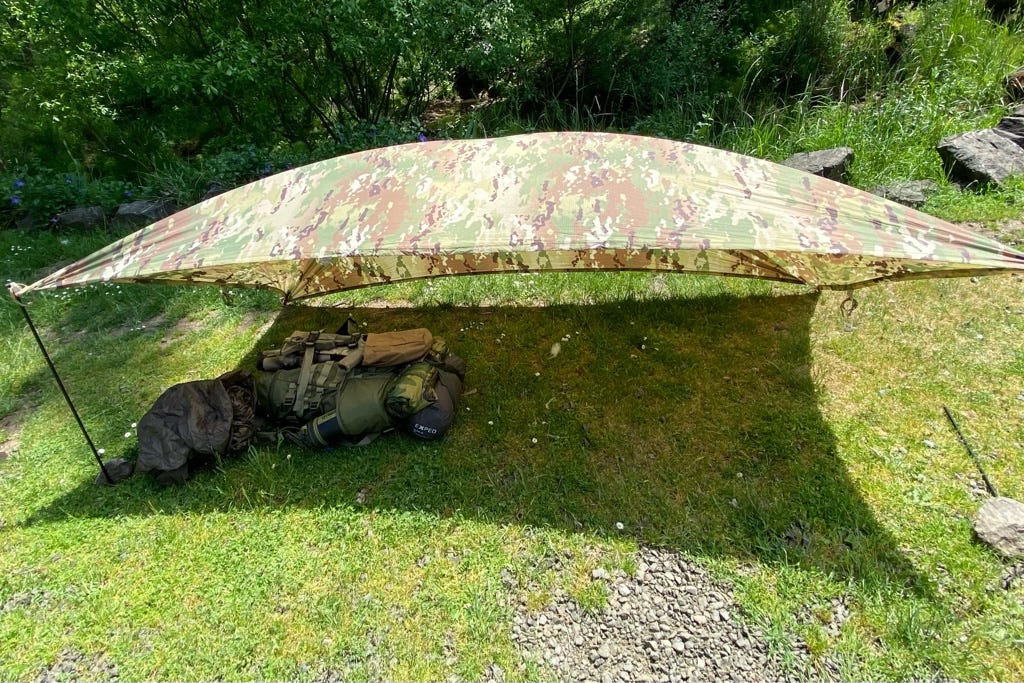I recently was introduced to the “Alpha Tent” by "@Disturbed" on Telegram and was surprised that I had never heard of it prior. It's been 30 years since it was put in print and he said he came up with the idea 38 years ago. I can't be sure of the "first" to make one, but it would seem that this webpage is of the original creator.
It’s a simple concept but the potential is awesome as you are not restricted to it use as a tent only, but in the original concept, being made with a poncho, you have the choices of wearing the poncho, using it as a tarp for shade or traditional rain cover or transforming it into an incredibly protective cocoon against the elements.
I use a Snug Pac Patrol Poncho for my rain gear which unlike a traditional poncho, has arms and does not layout flat. It works better than a standard poncho for rain protection and allows room to breath underneath so as to not sweat in it like a rain jacket, but has little potential as a tarp structure.
I do have a nice MEST Tarp though, and it is what I have chosen for my "Alpha Tent" build.
BUILDING IT
The MEST is 5'x8' so it provides a lot of room when setup which is better if your over 6ft tall as the traditional poncho creates a much smaller foot print and will likely put you into the fetal position to stay out of the rain.
Even so, at 6'-3" I'm just able to fit under the MEST Alpha Tent if I'm on my side or belly without lifting it off the ground on one end. In a heavy downpour and staked to the ground, it will be cozy. If I can lift the front and not have to worry about 10mph+ wind, it's very roomy.
I initially purchased two 14.5' Aluminum Tent Pole Replacements Kits and then cut them down but made the mistake of dividing and cutting end to end, forgetting that the male slip part does not count towards the OAL. I did have sense enough to leave one section at it's original 15" length with intent to slowly cut it down until I got the perfect fit and loft on the "tent". So I was able to establish the correct OAL of 115.5", but had one section longer than the rest.
I ordered another set of poles and plan to use (14) per set @ 8.250" per stick (not including the male portion that does NOT add to the OAL) for a more compact setup. As you can see below, it will allow the rods to easily fit inside the original MEST stuff sack.
EDIT: After receiving the 3rd set of poles, I decided that (12) sections @ 11.0" OAL was the best setup for me.
115" / 12 sections = 9.58" p/section + 1.42" hidden section = 11" OAL
This also allowed me to have (6) 11" sections remaining for (2) 28.74" poles to lift up a side of the shelter if wanted.
MEASUREMENTS
Just a rough diagonal measurement of the tarp gave me 107.5" OAL and the end measurement wound up being 115.5" so to get the perfect loft (poles not fighting each other or wanting to "snake" when installed) which is a 6.93% increase.
I've seen a rule of thumb for the GI Poncho version being 8% over the diagonal measurement. I'd start with rods AT LEAST this much longer before trimming to fit.
Don't forget the debur the pieces and smooth the edges after cutting! Your shock cord will last a lot longer if you take the time to do this right the first time. A four flute 3/8" counter sink bit works perfectly.
Properly cut lengths inserted into wirenut holders before bringing centers together. I have pieces of tape to make it easier to get everything lined up the first time. I was going to make a cross brass for this but once the poles are set they do not seem to move around, so KISS is just tape ID to find center fast and easy. This center crossover point might get a loop of 550 to hang a lantern on, but it does not need securing IMO.
The MEST has sewn in tabs instead of grommets, but they left a perfect fitting loop between bar tacks for a wirenut to fit in. I'm going to use Shoe-Goo to secure them in place.
With the rods tensioned, the wirenuts actually secure themselves tighter in the pocket. The bungie cords and stopper loops are for attaching Jungle Knots. I have them in the stuff sack if I want to use it as a tarp instead, but I anticipate using this config 99% of the time so I took them off for cleaner setup.
Bowing after putting centers together.
Top view.
Side view.
Cutting the rods shorter will flatten the sides out at the cost of loft. I chose not to do this for better ventilation and to keep the sides out off the ground.
FIELD USE
I really think I'm going to like this setup! Will post back when I have some field experience with it.
05.15.2023
So far I have left the tent out in the rain with my pack under it and a dry paper towel touching the MEST Tarp to see if I would get wet if any part of me was accidently touching the shelter in a downpour.
This is a concern given how I barely fit under it with the loft being what it is due to the rectangular dimensions as opposed to a GI Poncho that is more square. The towel stayed dry, and once I'm settled in under the tarp, I do not touch it with my shoulders.
Here you can see I set it up today to see how long it takes (<5min) and tried out the lifter poles that I had as left overs from buying the 3rd 14.5' pole and making the two crossing poles (12) pieces of 11" OAL.
Using the shock cord loops already attached for Jungle Knots, it was a simple twist and capture operation that is most secure. You can see I have a few sections taken out to lower the tent a bit, and I found that putting a rock on this preventing light breezes from moving it around. I carry (5) aluminum tent stakes with this kit that could be used to secure the poles and back of tent also if higher winds are an issue.
So far I'm thinking this Alpha Tent is the "Cat's Meow" for Winter AND Summer and the ability to setup a shade spot in 5 minutes without needing supports is awesome.












